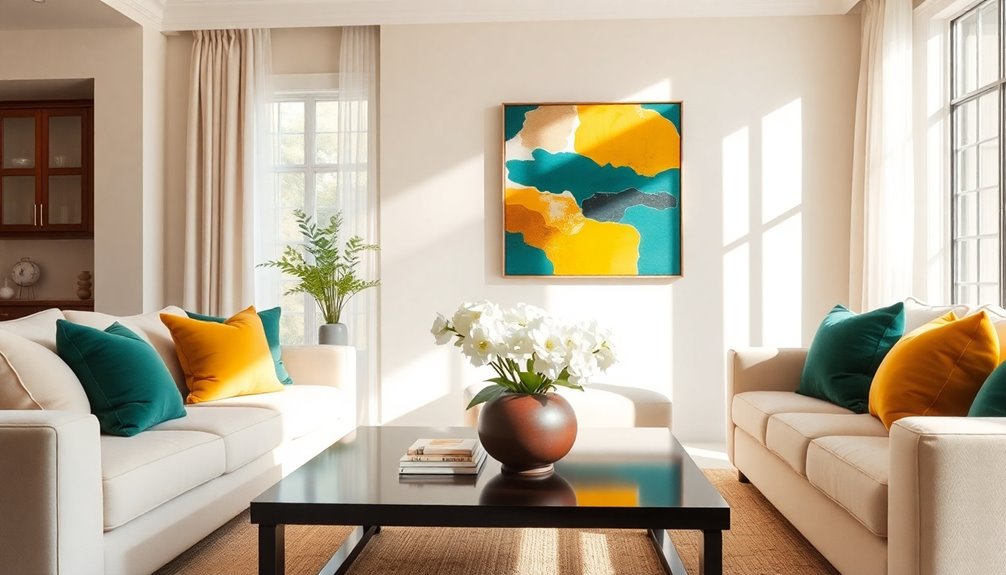You want your living room to pop, right? Perfect accent colors can bring balance and vibrancy, enhancing your overall design. Start by analyzing your existing color scheme and natural materials. If you've got a neutral palette, consider bold colors for impact. Testing color swatches on your walls is essential; look for how they change throughout the day. Remember, lighter shades make spaces feel larger while darker colors create coziness. By coordinating accent colors with your decor, you can achieve a cohesive look. Want to discover more tips on selecting the ideal shades? Keep exploring for more insights!
Key Takeaways
- Assess your existing decor and color scheme to determine the best accent colors that enhance contrast and complementarity.
- Consider the mood you want to create; blues and greens promote calmness, while yellows evoke joy.
- Test multiple paint swatches and sample pots to see how colors interact with your space over time.
- Use lighter colors to create a sense of spaciousness, or go for darker shades to add coziness in smaller living rooms.
- Ensure accent colors harmonize with architectural features and furniture to maintain a cohesive design aesthetic.
Purpose of Accent Colors
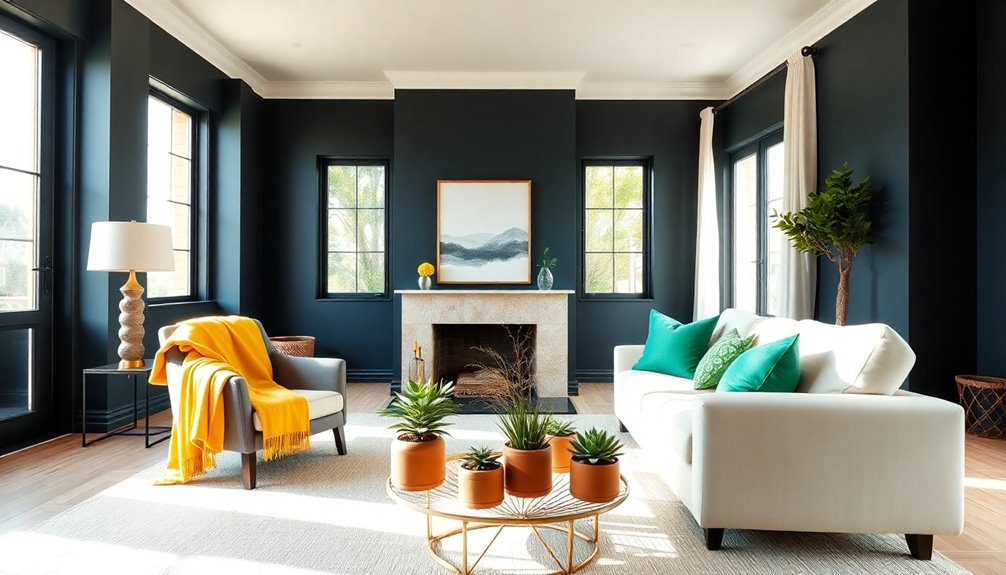
Accent colors serve a vital role in your living room's design, breathing life into your space. They enhance your color scheme by providing contrast and complementarity, which adds emphasis and visual interest. If your room feels monochromatic, a splash of accent color can inject drama and vibrancy. These colors also create continuity, helping to balance the overall look of the room while adding definition and dimension. Beyond aesthetics, accent colors can influence mood; for example, blues and greens promote calmness, while yellows evoke joy. The proper use of accent colors enhances overall aesthetics without overpowering the primary color palette.
Analyzing Your Color Palette
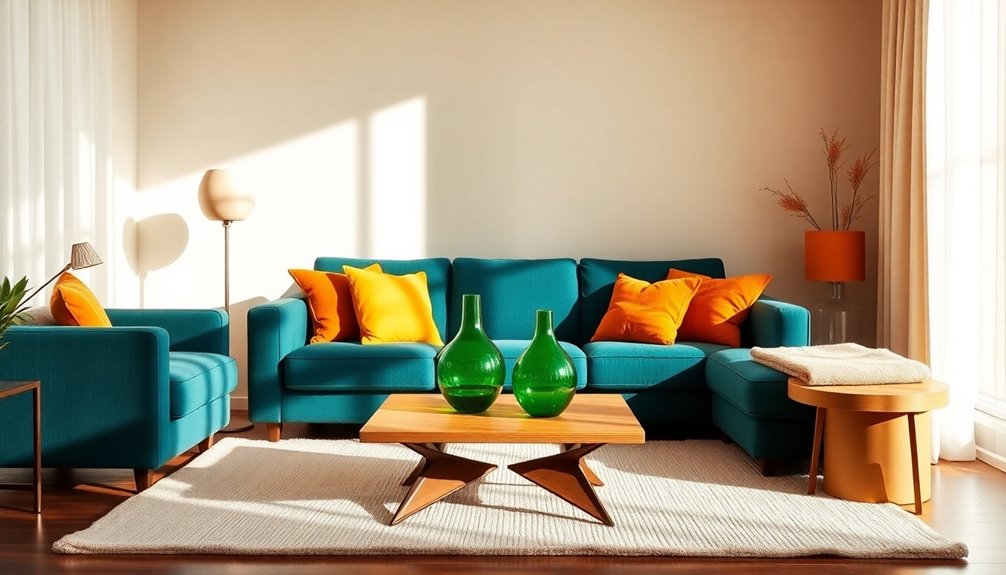
To create a vibrant living room, you'll want to analyze your color palette carefully.
Start by assessing existing elements like your green marble fireplace or herringbone hardwood floor. Consider your current furniture, such as black chairs with copper legs, as they'll influence your color choices. Incorporating natural materials like wood and stone can also enhance the overall aesthetic of your space.
Determine if your room's scheme is warm, cool, or neutral, and draw inspiration from artwork or upholstered sofas to find complementary colors. A well-chosen color scheme enhances the livability and aesthetics of your space by creating an inviting atmosphere.
Choose key colors based on your personal taste—select neutrals for a minimalist look or bold ones for a striking design.
Finally, ensure your chosen colors harmonize by exploring complementary, split-complementary, or analogous color schemes.
This thoughtful analysis will set a solid foundation for your living room's style.
Testing Colors in Your Space
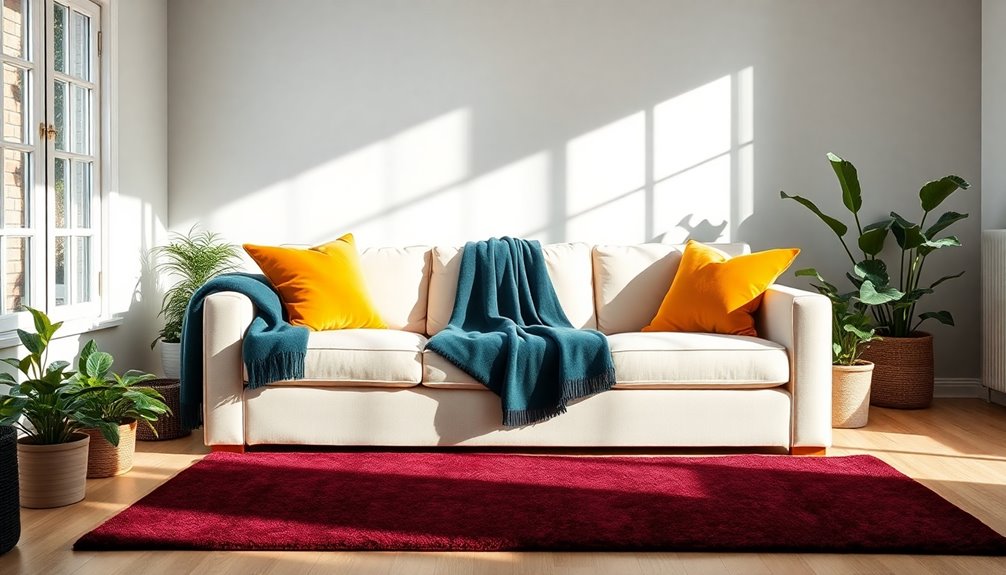
Before committing to a color scheme, it's crucial to test how those hues interact in your space. Start by using paint swatches to gauge how colors look against your existing decor.
Purchase sample pots of your top choices and paint sizable test patches on different walls. Observe these colors at various times of the day—morning light, afternoon sun, and evening artificial lighting can drastically change their appearance. Testing multiple shades, ideally three to five, helps you compare their effects. Live with the test patches for a few days to see how they influence your mood. Additionally, incorporating accent colors can significantly enhance the visual interest in your living room design.
Impact on Room Size

While choosing colors for your living room, consider how they can impact the perceived size of the space. Lighter colors like gray, white, and pastels make rooms feel larger. By painting the walls and ceiling the same light shade, you create the illusion of height, drawing the eye upward. If you want to elongate a room, paint one wall and the ceiling a darker color while keeping the other walls light. Conversely, using darker colors can make a small room feel cozier and intimate. An accent wall in a dark hue can add character while also shortening the room's length. Consistency in color across surfaces will enhance the open feel of your living space. Balancing light and dark tones will enhance the overall effect, creating a harmonious space that feels just right.
Coordinating With Decor Elements
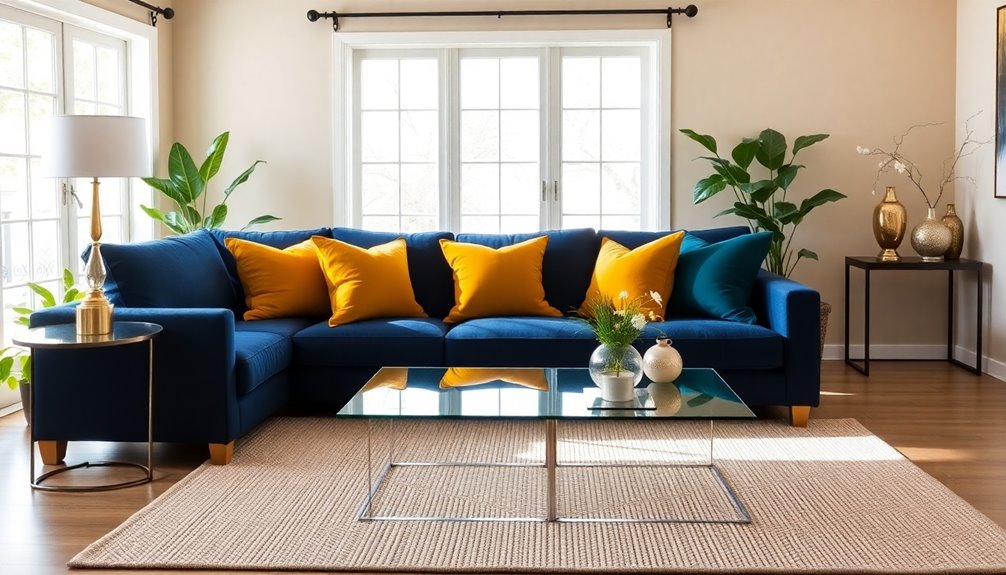
When you coordinate accent colors with your decor elements, you create a cohesive look that enhances the overall aesthetic of your living room.
Start by harmonizing with architectural features; for instance, a bold color like Sherwin-Williams Bold Brick can highlight a unique fireplace. If you've got large windows, opt for a soft shade like Repose Gray to keep the focus outside. Additionally, consider how natural light affects your color choice, as it can change the appearance of shades throughout the day. Incorporating warm colors can further enhance the inviting atmosphere of your living room.
Balance your furniture by choosing subdued colors for bold pieces, or vibrant hues if your furniture is neutral. Pair complementary colors, like blues with whites or greens with beiges, to achieve a balanced scheme.
Finally, select accent wall colors that fit your desired ambiance—darker shades for drama or softer tones for serenity.
Frequently Asked Questions
What Are the Best Accent Colors for Small Living Rooms?
When choosing accent colors for your small living room, consider using neutral shades like brilliant white or horseradish to create an airy feel.
Bold options, such as dark blue or teal, can add depth and distract from limited space.
Nature-inspired colors like sage and pastel yellow offer a soothing vibe, while dramatic hues like electric red or fuchsia can energize the room.
Mix and match to find what makes you feel most at home!
How Do I Choose an Accent Color for a Rental?
Choosing an accent color for your rental is like picking the right flower for a garden: it needs to stand out yet complement the whole.
Start by assessing your main color scheme, then think about the room's purpose—calming hues for relaxation, vibrant shades for energy.
Balance your choices using the 60-30-10 rule, and don't shy away from adding texture.
Can I Use Multiple Accent Colors in One Room?
Yes, you can definitely use multiple accent colors in one room! It adds depth and visual interest, creating a unique space.
Start by choosing a dominant main color and select complementary accent colors. Balance bold hues with neutrals to avoid overwhelming the room.
Gradually introduce these colors through accessories like pillows and rugs.
Remember to keep it cohesive, ensuring all colors work harmoniously together for a stunning look!
Are There Seasonal Trends for Living Room Accent Colors?
Imagine your living room as a canvas, where each season paints its own masterpiece.
Yes, seasonal trends for accent colors exist! In spring, think soft pastels; summer brings bold tropical vibes; fall wraps you in warm earth tones; and winter cools down with serene blues and metallics.
You can easily refresh your space by embracing these colors, letting each season's essence transform your living room into a welcoming retreat year-round.
How Do I Maintain My Accent Wall's Color Over Time?
To maintain your accent wall's color over time, choose durable, washable paint that resists scratches and UV fading.
Opt for a smooth finish for easier cleaning, and avoid textured options.
Regularly inspect the wall for wear and keep touch-up paint handy for minor repairs.
Monitor how the color appears in different lighting and establish a cleaning routine to keep it looking fresh.
Adjust as needed to maintain your desired look.
Conclusion
Now that you know the ins and outs of accent colors, you're ready to transform your living room into a vibrant oasis. Remember, it's all about balance; like a perfectly crafted symphony, each hue should harmonize with the others. Don't shy away from experimenting—test those colors in your space and see how they dance together. With a little creativity and confidence, you'll create an inviting atmosphere that reflects your unique style and personality.
